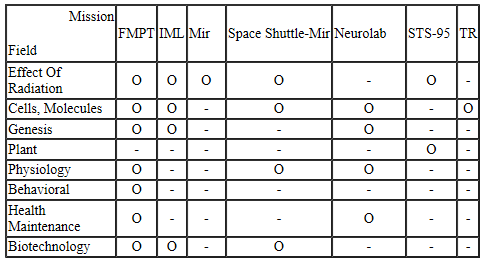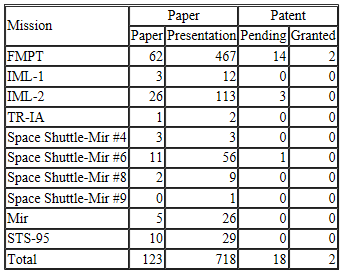This is an archive of information released in the past.
Disclaimer: It may contain broken links or outdated information. Some parts may not function in current web browsers.
*Visit https://humans-in-space.jaxa.jp/en/ for the latest information.

Experiment
- News
- Kibo Utilization Strategy
- Kibo Utilization Plan
- List of JAXA's Utilization Themes
- Experiment Facilities
- Space Environment Utilization
- Archive
Life Science Field
Life Science Experiments: Unraveling evolution and discovering the adaptability of life forms
Aspects of Life Science Utilizing the Space Environment
Gravity always exists on the ground. Every single life form is under its influence. Understanding gravity's influence on the life process will contribute to a better overall understanding on the fundamental biological mechanisms of the diversion, development, and evolution of animals, plants and humans.
If human beings are to be freed from the gravity of the Earth, and to stay in space for long periods of time or travel to other planets with different gravity conditions, we need to seek the answers to some very fundamental questions, such as, how does gravity affect the life forms, how do life forms sense their position in relations to gravity, how do life forms adjust themselves to gravity, gravitational change, and microgravity. Even if life forms are able to adapt to changes in gravity, there is a possibility that they will encounter physiological problems once they return to Earth.
It is a fact that long term stays in space results in several biological and medical problems. Some of these known problems are: deterioration of the bones and muscles, changes in the immune system, decreases in the number of red blood cells, weakening of cardiac muscle and psychological problems resulting from staying in a closed environment for a long period of time. Research on gravity's effects on the various physiological responses is also expected to contribute to a greater understanding on the underlying causes of such clinical conditions as osteoporosis and the dysfunctional sense of balance.
Biological changes in Space
How does the human body change in space? The following are some brief explanations on the physiological effects on the astronaut's body while in space.
- Swollen Face
On Earth, body fluids, such as blood, are pulled downwards by the force of gravity. The heart pumps the blood throughout the body against this gravitational pull. However, this gravitational pull does not exist in a microgravity environment. As a result, the blood migrates (fluid shift) to the upper portions of the body, thus causing a swollen face. - Bones and Muscles Weaken, whereas Height Increases
In a gravitational environment, the bones store calcium to maintain the bone's strength. The muscles work to maintain the posture of the body (antigravity muscle). Under microgravity, the body will float in the air, thus reducing stress on the bones. As the need for bone strength decreases, the calcium in the bones is absorbed into the blood and excreted in urine. As a result, the bones become fragile similar to the osteoporosis condition found on Earth.
In addition, in a microgravity environment the muscles will grow weaker and shrink (muscle atrophy). If you measure your height right before going to sleep at night and upon waking in the morning, you will discover that you're a little bit taller. Similarly, the spine will stretch in space where there is no gravity for the body to support against, thus increasing one's height by a few centimeters. - Space Sickness
Space sickness is a condition similar to motion sickness on Earth. Symptoms include: sudden nausea and vomiting, along with a sense of heavy headedness and lethargy. This occurs within the first minutes to several hours of being exposed to a microgravity environment. Space sickness vanishes in a few days. The causes of space sickness are thought to be, movement of the body fluid to the head or confusion in the brain's processing of the body's sensory input. This confusion is caused by information from the vestibular system that controls the balancing senses from the inside of the ears and the visual information from the eyes being different from what's normally perceived on the ground.
Space Environment and Life
Life Science research aims to explore what is going on in the body of the life forms under microgravity and attempting to understand the mechanisms of generation, differentiation and morphogenesis of life forms on Earth. The following section provides a brief explanation on the objectives and focus of Life Science.
- Changes in Gene Expression
This field of research focuses on changes in the gene expression resulting from exposure to the space environment. This research attempts to answer questions such as: What types of genes expression of various creatures would be strengthened or weakened as results of changes in gravity and spaceflight? What characteristics and functions would proteins produced by those genes have? Is it possible to suppress or enhance the phenotype, as a result of gravitational change, by means of controlling the gene expression? Is it possible to biogenetically modify the organisms so as to facilitate adaptation to the space environment? - Reception and Cell's Response Mechanisms to Gravity
One of the vital questions concerning cells is whether a single cell can sense and respond to gravity. Supposing that it can, how do cells respond to gravity? How do the individual cells in complex life forms sense the directions and forces of gravity? How do gravity-sensing cells convey this data from their receptors to signaling cascades in the cells? How does gravity sensing cells and cells that responds physiologically to gravity exchange data? To conduct this exchanging process, what types of enzymatic and metabolic systems are interacting? The research in this field is striving to discover answers to questions similar to those posed above. - Genesis of the Life Forms
During the formation of the organism's tissues or organs, information exchange and coordination between the various cells takes place. Will there be a 'critical stage' where the normal embryo in its development phase will be 'critically influenced' by factors relating to gravitational changes and spaceflight? If so, how will the normal embryo mutate? What types of genes, genetic products or altered metabolism will be observed.
What are the indicators for polyphyletic and adaptability? This field of research attempts to understand how changes in gravity will affect the early embryogenesis and morphogenesis. - Comparative Biology
This field of research focuses on: a comparison of different life forms and their responses to exposure in a space environment. Comparative Biology focuses on the types of effects on functions of physiological activity, metabolism and mature biota upon short term or long term exposure to gravitational changes and other space environment factors. In addition, a focus on what different types will appear in diverse biota.
History of Life Science Experiments in Space
Space experiments on life forms began to be conducted before the first human space flight. The primary interest at that time was, "Will life forms be capable of surviving space flight?" and "What types of effects will the space environment have on the life forms?" The United States and the former Soviet Union placed various life forms in their spacecrafts and launched them into space. Based on the results of those experiments, the U.S. eventually succeeded in the Apollo Project by sending astronauts to and getting them return from the Moon. During the Skylab Project, an extension of the Apollo Project, experiments focused on long term manned space flight and its effect. At this point, the purposes of the experiments were to discover what the effects on life form that had been exposed to a space environment were Most of these experiments were conducted with a "just try and do it" types of experiment philosophy.
By the time the Space Shuttle and the Spacelab flights began to be conducted, the knowledge on the effects of the space environment on life forms, such as human beings, was understood to a certain extent. This enabled the planning of experiments based on certain hypothesis. The first flight of the Space Shuttle took place in 1981. About the same time, "Molecular Biology" or the method centering on the analysis of genes started to become established. Molecular Biology started to become actively assimilated into space Life Science experiments during the late 1990s.
NASDA (October 1, 2003 - JAXA) started space experiment projects in 1979, the time when qualitative changes in life Science experiments were taking place. However, the first Japanese on-orbit experiment was finally conducted in 1992. The following is a list of the flights where the experiments took place, fields the experiments covered, and the number of papers written on the space experiments.
![]() Japanese Experiments: Flights and Experiments
Japanese Experiments: Flights and Experiments

![]() Number of published papers and filed patents resulting from the space experiments
Number of published papers and filed patents resulting from the space experiments

| Copyright 2007 Japan Aerospace Exploration Agency | Site Policy |